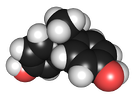Anyone who's ever pulled an all-nighter to finish a project knows how it wreaks havoc with your metabolism. The fact is, it's not just a nicety to be awake and active during the day and sleep at night: it's the way bodies are hard-wired. Scientists have long-suspected that upsets in a person's biological clock could play a factor in the development of metabolic disorders like diabetes. Now a team of researchers from three Southern California universities has made surprising discoveries that support that hypothesis. Not only have they isolated the protein that regulates the biologic clock (and named it cryptochrome), but they have found a molecule called KL001 that dictates when cryptochrome gets sent to the proteasome recycling bin. Which is to say, they now know a lot more about this complex circadian system that not only tells the body when to sleep and wake, but also how the body should manage glucose levels in those periods of relative activity and dormancy. The bio research study was published in the July 13 advance online issue of the journal Science.
Tags: CA, University of California San Diego, University of Southern California, Diabetes, Southwest, California, 2012, University of California Santa Barbara, USC, Los Angeles, Biochemistry, Scripps, biology research, bio research, Front Line event, NSF
The summer of 2012 is set to go down as one of the driest and worst years for US farmers, but it's proving to be an excellent season for fruit science, especially at the University of Arizona, Tucson. In June we saw the sequencing of the tomato genome (technically a fruit), which was a breakthrough in genetics research. The Arizona Genomics Institute has now cracked another complex code: the genome of the banana.
Tags: University of Arizona, DNA Sequencing, genomic research, DNA Research, genome research, banana, University of Arizona Tucson Research, Southwest, 2012, biology research, Arizona, AZ, Genetics, Front Line event, genomics research, Tucson, UA
 A few weeks ago the Food and Drug Administration announced a ban on the chemical bisphenol A (BPA) in all baby bottles and plastic children's cups. BPA is an estrogen-mimicking molecule that can cause significant developmental problems in children. The federal ban comes on the heels of several state BPA bans, including one in Washington State.
A few weeks ago the Food and Drug Administration announced a ban on the chemical bisphenol A (BPA) in all baby bottles and plastic children's cups. BPA is an estrogen-mimicking molecule that can cause significant developmental problems in children. The federal ban comes on the heels of several state BPA bans, including one in Washington State.
Tags: Washington, WA, Northwest, chemical research, Washington State University, 2012, Genetics, Front Line event, science current event
By now you've probably heard about 3D bio printing, a bioengineering technique for literally building functional replacement tissue and eventually organs. (Read an earlier blog of ours on the subject.) While still in the early stages of development in terms of actually producing a human organ for transplant, the technology is advancing and critical problems are being met with innovative solutions. In the July issue of Nature Materials, University of Pennsylvania scientists, in conjunction with MIT and Harvard researchers, published an article documenting their success creating a blood vessel network using sugar.
Tags: Pennsylvania, Northeast, University of Pennsylvania, UPenn, 2012, Cell Research, bioprinting, bio research, Philadelphia, BioResearch Product Faire Event, Research, Front Line event, PA, BRPF, scientist solutions, science solution
The University of Hawaii Cancer Center has successfully renewed its National Cancer Institute (NCI) designation and is on schedule to open its new world-class cancer research and treatment facility near the John A. Burns School of Medicine (JABSOM) in the Kaka’ako district of Honolulu early next year. The Hawaiian biomedical research center is the only NCI-level facility in the Pacific Islands and one of only 66 NCI research organizations in the U.S. The island state may be a tropical paradise and vacation destination in the popular imagination, but there's no doubt that its capital city is also becoming a serious biomedical research magnet as well.
Tags: biomedical research, Bioresearch, Biomedical expansion, University of Hawaii, cancer research, New research facilities, new science wet labs, Southwest, 2012, Hawaii, Cancer, Front Line event, Honolulu, HI, new construction, Cancer Center
Oregon Health and Science University (OHSU) recently received $245,115 in new NIH science research funding for a study of the effectiveness of two drugs commonly used to restore heart function in cardiac arrest victims. Researchers will be determining whether the drugs Amiodarone and Lidocaine actually improve cardiac arrest patients' chance of survival, and if so which is more effective. These drugs are both used to restore the loss of rhythmic and regular heartbeats that is a common cause of cardiac arrest, though their overall effectiveness at improving survival among patients has not been well documented. Typically first responders pick one or the other, but their decisions are not based on hard comparative evidence of the drugs' benefits.
Tags: Northeast, Oregon Health Sciences University, Oregon, 2012, Cardiac Arrest, Front Line event, NIH, OR, OHSU, Portland, BRPF
Construction has begun on a new research building at the University of Oregon, which will house new lab space for the Oregon Research Institute. The expansion of Oregon Research lab space is an important step for this growing institute, which is by far the largest and top funded independent research center in Oregon.
Tags: UOr, New research facilities, University of Oregon, Oregon, 2012, Front Line event, OR, Eugene
 Oregon State University recently opened a new nutritional sciences building with the help of a record donation from philanthropists Bob and Charlee Moore, founders of Bob’s Red Mill Natural Foods (photo courtesy of Oregonlive). The new facility was named the Moore Family Center for Whole Grain Foods, Nutrition and Preventive Health in their honor.
Oregon State University recently opened a new nutritional sciences building with the help of a record donation from philanthropists Bob and Charlee Moore, founders of Bob’s Red Mill Natural Foods (photo courtesy of Oregonlive). The new facility was named the Moore Family Center for Whole Grain Foods, Nutrition and Preventive Health in their honor.
Tags: Oregon State University, New research facilities, Oregon, 2012, Front Line event, OR, Corvallis, new construction, OSU, ORSTU
In 1962, the Seattle World's Fair was held in the northwestern capital city. The legacy of that event goes well beyond the iconic Seattle Space Needle (right) and is explored in a panoply of summer and fall educational and entertainment festivities celebrating the 50th Anniversary. One of the "Next50" happenings is an interactive exhibit to highlight the role of Washington State's life science research innovations in addressing global health challenges. If space exploration was the governing dream of the near future in the 1960's, our generation's overriding fascination may be with possibilties inherent in life science research discoveries and their applications for transforming the health of millions of people worldwide in order to lead fuller, longer lives.
Tags: UW, University of Washington, Northwest, Lab-on-a-chip Technology, 2012, science event, Event, Front Line event, science current event, Seattle, bioscience event, Science research hub, scientist solutions, Exhibit space
 The University of Southern California has a thriving regenerative medicine research headquarters at the Broad Center within the Keck School of Medicine. Established in 2006, the Center's $80M state-of-the-art building opened in 2010 to house eleven research teams and four core laboratories. In addition to seeking out therapeutics, though, a team of USC stem cell scientists is marrying their study of stem cell functioning to a more thorough understanding of regenerative biology as it happens naturally in many species of animal. Drs. Cheng-Ming Chuong, Randall B. Widelitz (right), Ping Wu, and Ting-Xin Jiang of the Department of Pathology discuss their lab research, which looks at stem cells in hair and feathers in particular, in a recent article published in the journal Physiology.
The University of Southern California has a thriving regenerative medicine research headquarters at the Broad Center within the Keck School of Medicine. Established in 2006, the Center's $80M state-of-the-art building opened in 2010 to house eleven research teams and four core laboratories. In addition to seeking out therapeutics, though, a team of USC stem cell scientists is marrying their study of stem cell functioning to a more thorough understanding of regenerative biology as it happens naturally in many species of animal. Drs. Cheng-Ming Chuong, Randall B. Widelitz (right), Ping Wu, and Ting-Xin Jiang of the Department of Pathology discuss their lab research, which looks at stem cells in hair and feathers in particular, in a recent article published in the journal Physiology.
Tags: University of Southern California, Stem cell research, USC Science, Southwest, California, Los Angeles, animal science, biology research, Front Line event

